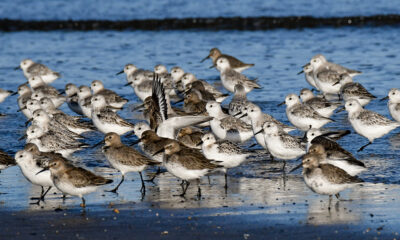
Twice each year, about 4 billion birds in North America make what can only be described as a series of continuous ultramarathons — flying unbelievably taxing journeys north and south between the Americas, sometimes flying for days at a time over open water, without eating, sleeping, or touching down. Making these migratory journeys is so extreme and perilous that scientists believe 2.6 billion birds each year do not complete the journey.
For many birds, the migration is so intense that they have to make serious adaptations to their lives and bodies in order to undertake their journey. As technology gets more advanced, and tracking devices become lighter, scientists are able to gain more information about birds on their migrations, and what they are learning is fascinating!
What kinds of things do birds do to get themselves physically fit for migration? The answers might surprise you.
- Bulk up: Some birds like warblers, hummingbirds, and long-distance migrating shorebirds even double their body weight before leaving on migration. Some birds like Red Knots who in the fall will fly nonstop for several days – will get so fat they can barely get off the ground! But they need that extra fat – all of which they use – to get between the Americas in one pass. Read more about which birds do this in this Cornell article.
- Know when to leave: In spring, Red Knots must time their arrival in Delaware Bay just when horseshoe crabs traditionally come ashore to mate, so migration timing is critical. The protein provided by the eggs from horseshoe crabs will give them the energy and ability to complete their migration northward. If the horseshoe crabs aren’t there or their populations have decreased, the birds may not have enough energy to make it to their nesting grounds, or if they do, they might not be able to breed. Other birds need to time their arrival on nesting grounds to exactly when the food they require to restore themselves from migration is available. Climate change and a warmer planet is beginning to change when this happens. So when birds are cued by the length of day or certain weather patterns where they are to know when to leave, there are increasing instances of them missing their food source altogether and being unable to complete their journey, or breed.
- Transform their internal organs: For some of these long-distance migrants, if they can’t make it on the fat reserves they’ve made for themselves, they have the ability to transform their internal organs and muscles to use as food while on the wing. Then when the birds land, if they survive the flight, their organs begin to convert back to normal as the birds start gorging on food.
These are just a few examples of what birds must do to make these treacherous flights. This article by Audubon has more info on what birds are capable of to meet the extreme needs of migration. And if you want an even more comprehensive look at migrating birds, read Scott Weidensaul’s amazing book A World on the Wing.